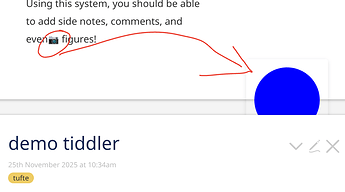First of all, this is not a TiddlyWiki, although I could do the same there. It is a plain HTML page that stole a lot of TW CSS.
The HTML has two divs side-by-side, #gutter and #content. Each verse numbers’ markup inside the gutter looks like this:
<div class="verse-number" style="margin-top: 36px">
<a class="tc-tiddlylink" data-verse="Genesis 1:3" title="Genesis 1:3" href="#Genesis 1:3">3</a>
</div>
And the verse content markup looks like this:
<p>
<span class="verse" data-verse="Genesis 1:3">And God said, Let there be light: and there was
light.</span>
<span class="verse" data-verse="Genesis 1:4">And God saw the light, that <em>it was</em> good: and
God divided the light from the darkness.</span>
<span class="verse" data-verse="Genesis 1:5">And God called the light Day, and the darkness he
called Night. And the evening and the morning were the first day.</span>
</p>
The part that really needed hardcoding was verse numbers’ margin-top, which I simply eyeballed one-by-one, pushing them down the page to match with the verse content.
I only did it to create this demonstration. I never found a good way to automate it. In fact, I’m pretty sure this is a dead-end, unless I want to run some JS to calculate these offsets based on the actual rendered layout of the verses. While I’m fairly certain I could figure this out, it seems fragile and very much not in the spirit of TiddlyWiki.
Additional HTML content
<div class="chapter side-by-side tc-eventcatcher">
<div class="gutter">
<div class="verse-number" style="margin-top: 15px">
<a class="tc-tiddlylink" data-verse="Genesis 1:1" title="Genesis 1:1" href="#Genesis 1:1">1</a>
</div>
<div class="verse-number" style="margin-top: 0px">
<a class="tc-tiddlylink" data-verse="Genesis 1:2" title="Genesis 1:2" href="#Genesis 1:2">2</a>
</div>
<div class="verse-number" style="margin-top: 36px">
<a class="tc-tiddlylink" data-verse="Genesis 1:3" title="Genesis 1:3" href="#Genesis 1:3">3</a>
</div>
<div class="verse-number" style="margin-top: 0px">
<a class="tc-tiddlylink" data-verse="Genesis 1:4" title="Genesis 1:4" href="#Genesis 1:4">4</a>
</div>
<div class="verse-number" style="margin-top: 0px">
<a class="tc-tiddlylink" data-verse="Genesis 1:5" title="Genesis 1:5" href="#Genesis 1:5">5</a>
</div>
<div class="verse-number" style="margin-top: 38px">
<a class="tc-tiddlylink" data-verse="Genesis 1:6" title="Genesis 1:6" href="#Genesis 1:6">6</a>
</div>
<!-- ... -->
<div class="verse-number" style="margin-top: 59px">
<a class="tc-tiddlylink" data-verse="Genesis 1:31" title="Genesis 1:31"
href="#Genesis 1:31">31</a>
</div>
</div>
<div class="content">
<p>
<span class="verse" data-verse="Genesis 1:1">In the beginning God created the heaven and the
earth.</span>
<span class="verse" data-verse="Genesis 1:2">And the earth was without form, and void; and
darkness <em>was</em> upon the face of the deep. And the Spirit of God moved upon the face of
the waters.</span>
</p>
<p>
<span class="verse" data-verse="Genesis 1:3">And God said, Let there be light: and there was
light.</span>
<span class="verse" data-verse="Genesis 1:4">And God saw the light, that <em>it was</em> good: and
God divided the light from the darkness.</span>
<span class="verse" data-verse="Genesis 1:5">And God called the light Day, and the darkness he
called Night. And the evening and the morning were the first day.</span>
</p>
<!-- ... -->
<p>
<span class="verse" data-verse="Genesis 1:31">And God saw every thing that he had made, and,
behold, <em>it was</em> very good. And the evening and the morning were the sixth day.</span>
</p>
</div>

